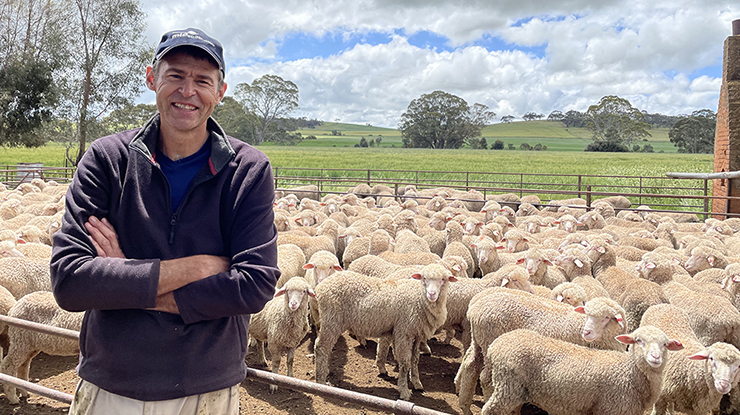 SA sheep producer Brett Nietschke was involved in the MLA-supported Barossa Improved Grazing Group project.
SA sheep producer Brett Nietschke was involved in the MLA-supported Barossa Improved Grazing Group project.
A contained solution to boost lambing and ground cover
Key points
- As they enter containment, Brett condition scores ewes and continues to monitor scores throughout the six to eight weeks they are contained.
- In early April, he pregnancy scans ewes and separates them into singles, multiples and dries.
- In June, he releases ewes back onto pasture 10 days before lambing.
After several dry years, SA sheep producer Brett Nietschke turned to containment feeding in an attempt to maintain ground cover and encourage better pasture recovery in the lead-up to lambing.
His property was part of the MLA-funded Barossa Improved Grazing Group (BIGG) Producer Demonstration Site (PDS) project.
“Primarily, we wanted to protect ground cover and ensure we had some feed on offer in the paddocks leading up to lambing in June or July,” Brett said.
“Putting the ewes in containment gave us the best chance to do that.”
Brett runs a self-replacing Merino flock, predominantly for wool production, with 400 Merino breeding ewes and 200 ewe hoggets.
As part of the PDS, 400 ewes were in containment.
Brett crops around 70% of the property, with the remaining 30% pasture.
Most cereal crops are grazed early to allow some extra short-term feed for the winter feed gap.
Preparing for containment
The containment area was set up at very low cost, comprising a 4ha paddock which was temporarily divided in half to separate twin and single-bearing ewes.
Prior to containment, all ewes were pregnancy scanned and separated, then moved into containment six to eight weeks prior to lambing.
The ewes were also condition scored throughout the containment period, with twins being held close to the condition score target of 3.3–3.5 and singles at a slightly lower score.
Containment ration
For the twins, Brett used lick feeders with a ration of grain, and hay was rolled out in the pens.
The single-bearing ewes were generally fed a ration of good quality hay only.
Lambing paddocks
The ewes were moved out of containment for lambing onto either regenerated clover-based pasture or sown pasture paddocks 10 days before lambing.
The twin ewes were released onto pasture paddocks ranging from 6–15ha, with 50–80 head per mob. The singles were released onto a 15ha paddock.
“The containment period allowed the pasture to really get away for lambing, but we had late breaks and the pasture took longer to re-establish, so it wasn’t supplying adequate feed in the lead-up to lambing,” Brett said.
“As a result, twin-bearing ewes still had access to grain and the singles had additional hay.
“We recorded 116% lambing (to ewes joined), probably helped by fortunate weather conditions during lambing and the ideal condition score of the ewes.”
Ewe survival
The ewe mortality rate from the start of containment through to lamb marking was 3%.
All deaths were twin-bearing ewes, which Brett said was likely as a result of pregnancy toxaemia.
Ease of management
Brett found containment to be a very worthwhile management practice and saw very few disadvantages.
“We were able to more easily maintain condition scores until release from containment and we also saw an improvement in lambing percentage in that first year,” he said. “
The containment yards made hand feeding easier and more costeffective. It also reduced the feed requirement as ewes weren’t wasting energy walking around a paddock.
“After four years, we can see the benefits of using containment to manage ewe nutrition and pasture far outweigh the costs, and we’ll be continuing to use it as part of our ongoing practice.”



